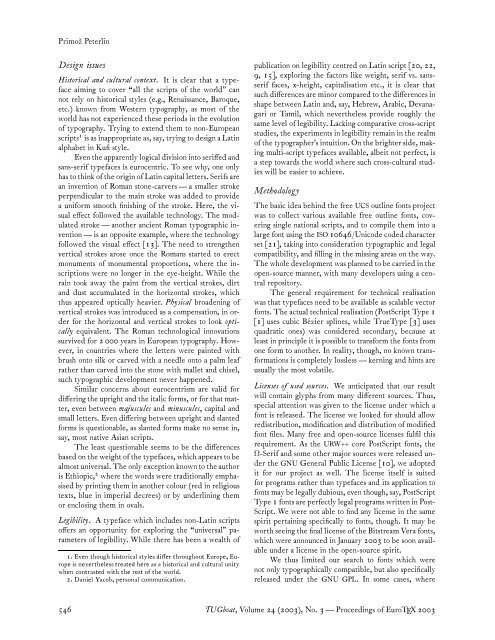The Free UCS Outline Fonts Project — an Attempt to Create a ... - TUG
The Free UCS Outline Fonts Project — an Attempt to Create a ... - TUG
The Free UCS Outline Fonts Project — an Attempt to Create a ... - TUG
Create successful ePaper yourself
Turn your PDF publications into a flip-book with our unique Google optimized e-Paper software.
PrimožPeterlin<br />
Design issues<br />
His<strong>to</strong>rical <strong>an</strong>d cultural context. It is clear that a typeface<br />
aiming <strong>to</strong> cover “all the scripts of the world” c<strong>an</strong><br />
not rely on his<strong>to</strong>rical styles (e.g., Renaiss<strong>an</strong>ce, Baroque,<br />
etc.) known from Western typography, as most of the<br />
worldhasnotexperiencedtheseperiodsintheevolution<br />
of typography. Trying <strong>to</strong> extend them <strong>to</strong> non-Europe<strong>an</strong><br />
scripts 1 isasinappropriateas,say,trying<strong>to</strong>designaLatin<br />
alphabetinKufi style.<br />
Eventheapparentlylogicaldivisionin<strong>to</strong>seriffed<strong>an</strong>d<br />
s<strong>an</strong>s-serif typefaces is eurocentric. To see why, one only<br />
has<strong>to</strong>thinkoftheoriginofLatincapitalletters.Serifsare<br />
<strong>an</strong> invention of Rom<strong>an</strong> s<strong>to</strong>ne-carvers<strong>—</strong>a smaller stroke<br />
perpendicular <strong>to</strong> the main stroke was added <strong>to</strong> provide<br />
a uniform smooth finishing of the stroke. Here, the visual<br />
effect followed the available technology. <strong>The</strong> modulated<br />
stroke<strong>—</strong><strong>an</strong>other <strong>an</strong>cient Rom<strong>an</strong> typographic invention<strong>—</strong>is<strong>an</strong>oppositeexample,wherethetechnology<br />
followed the visual effect [13]. <strong>The</strong> need <strong>to</strong> strengthen<br />
vertical strokes arose once the Rom<strong>an</strong>s started <strong>to</strong> erect<br />
monuments of monumental proportions, where the inscriptions<br />
were no longer in the eye-height. While the<br />
rain <strong>to</strong>ok away the paint from the vertical strokes, dirt<br />
<strong>an</strong>d dust accumulated in the horizontal strokes, which<br />
thus appeared optically heavier. Physical broadening of<br />
verticalstrokes wasintroduced as acompensation, inorder<br />
for the horizontal <strong>an</strong>d vertical strokes <strong>to</strong> look optically<br />
equivalent. <strong>The</strong> Rom<strong>an</strong> technological innovations<br />
survivedfor 2000 years inEurope<strong>an</strong> typography. However,<br />
in countries where the letters were painted with<br />
brush on<strong>to</strong> silk or carved with a needle on<strong>to</strong> a palm leaf<br />
ratherth<strong>an</strong>carvedin<strong>to</strong>thes<strong>to</strong>newithmallet<strong>an</strong>dchisel,<br />
suchtypographic developmentneverhappened.<br />
Similar concerns about eurocentrism are valid for<br />
differingtheupright<strong>an</strong>dtheitalicforms,orforthatmatter,<br />
even between majuscules <strong>an</strong>d minuscules, capital <strong>an</strong>d<br />
smallletters.Evendifferingbetweenupright<strong>an</strong>dsl<strong>an</strong>ted<br />
forms isquestionable,as sl<strong>an</strong>tedforms make no sense in,<br />
say, most nativeAsi<strong>an</strong>scripts.<br />
<strong>The</strong> least questionable seems <strong>to</strong> be the differences<br />
basedontheweigh<strong>to</strong>fthetypefaces,whichappears<strong>to</strong>be<br />
almostuniversal.<strong>The</strong>onlyexceptionknown<strong>to</strong>theauthor<br />
isEthiopic, 2 wherethewordsweretraditionallyemphasisedbyprintingthemin<strong>an</strong>othercolour(redinreligious<br />
texts, blue in imperial decrees) or by underlining them<br />
or enclosingtheminovals.<br />
Legibility. A typeface which includes non-Latin scripts<br />
offers <strong>an</strong> opportunity for exploring the “universal” parameters<br />
of legibility. While there has been a wealth of<br />
1. Eventhoughhis<strong>to</strong>ricalstylesdifferthroughoutEurope,Europeisneverthelesstreatedhereasahis<strong>to</strong>rical<strong>an</strong>dculturalunity<br />
when contrasted with the rest of the world.<br />
2. D<strong>an</strong>iel Yacob, personal communication.<br />
publicationonlegibilitycentredonLatinscript[20,22,<br />
9, 15], exploring the fac<strong>to</strong>rs like weight, serif vs. s<strong>an</strong>sserif<br />
faces, x-height, capitalisation etc., it is clear that<br />
suchdifferencesareminorcompared<strong>to</strong>thedifferencesin<br />
shapebetweenLatin<strong>an</strong>d,say,Hebrew,Arabic,Dev<strong>an</strong>agari<br />
or Tamil, which nevertheless provide roughly the<br />
sameleveloflegibility.Lackingcomparativecross-script<br />
studies,theexperimentsinlegibilityremainintherealm<br />
ofthetypographer’sintuition.Onthebrighterside,makingmulti-scripttypefacesavailable,albeitnotperfect,is<br />
astep<strong>to</strong>wardstheworldwheresuchcross-culturalstudieswillbe<br />
easier<strong>to</strong> achieve.<br />
Methodology<br />
<strong>The</strong>basicideabehindthefree<strong>UCS</strong>outlinefontsproject<br />
was <strong>to</strong> collect various available free outline fonts, covering<br />
single national scripts, <strong>an</strong>d <strong>to</strong> compile them in<strong>to</strong> a<br />
largefontusingtheISO10646/Unicodecodedcharacter<br />
set [21], taking in<strong>to</strong> consideration typographic <strong>an</strong>d legal<br />
compatibility,<strong>an</strong>dfillinginthemissingareasontheway.<br />
<strong>The</strong>wholedevelopmentwaspl<strong>an</strong>ned<strong>to</strong>becarriedinthe<br />
open-source m<strong>an</strong>ner, with m<strong>an</strong>y developers using a central<br />
reposi<strong>to</strong>ry.<br />
<strong>The</strong> general requirement for technical realisation<br />
wasthattypefacesneed<strong>to</strong>beavailableasscalablevec<strong>to</strong>r<br />
fonts.<strong>The</strong>actualtechnicalrealisation(PostScriptType1<br />
[1] uses cubic Bézier splines, while TrueType [3] uses<br />
quadratic ones) was considered secondary, because at<br />
leastinprincipleitispossible<strong>to</strong>tr<strong>an</strong>sformthefontsfrom<br />
oneform<strong>to</strong><strong>an</strong>other.Inreality,though,noknowntr<strong>an</strong>sformationsiscompletelylossless<strong>—</strong>kerning<strong>an</strong>dhintsare<br />
usuallythemost volatile.<br />
Licenses of used sources. We <strong>an</strong>ticipated that our result<br />
will contain glyphs from m<strong>an</strong>y different sources. Thus,<br />
special attention was given <strong>to</strong> the license under which a<br />
font is released. <strong>The</strong> license we looked for should allow<br />
redistribution,modification<strong>an</strong>ddistributionofmodified<br />
font files. M<strong>an</strong>y free <strong>an</strong>d open-source licenses fulfil this<br />
requirement. As the URW++ core PostScript fonts, the<br />
Ω-Serif<strong>an</strong>dsomeothermajorsourceswerereleasedunder<br />
the GNU General Public License [10], we adopted<br />
it for our project as well. <strong>The</strong> license itself is suited<br />
for programs rather th<strong>an</strong> typefaces<strong>an</strong>d itsapplication<strong>to</strong><br />
fontsmaybelegallydubious,eventhough,say,PostScript<br />
Type1fontsareperfectlylegalprogramswritteninPost-<br />
Script. We were not able <strong>to</strong> find <strong>an</strong>y license in the same<br />
spirit pertaining specifically <strong>to</strong> fonts, though. It may be<br />
worthseeingthefinallicenseoftheBitstreamVerafonts,<br />
whichwere<strong>an</strong>nouncedinJ<strong>an</strong>uary2003<strong>to</strong>besoonavailableunderalicenseinthe<br />
open-sourcespirit.<br />
We thus limited our search <strong>to</strong> fonts which were<br />
no<strong>to</strong>nlytypographicallycompatible,butalsospecifically<br />
released under the GNU GPL. In some cases, where<br />
546 <strong>TUG</strong>boat,Volume24 (2003), No. 3<strong>—</strong>Proceedingsof EuroTEX2003

















